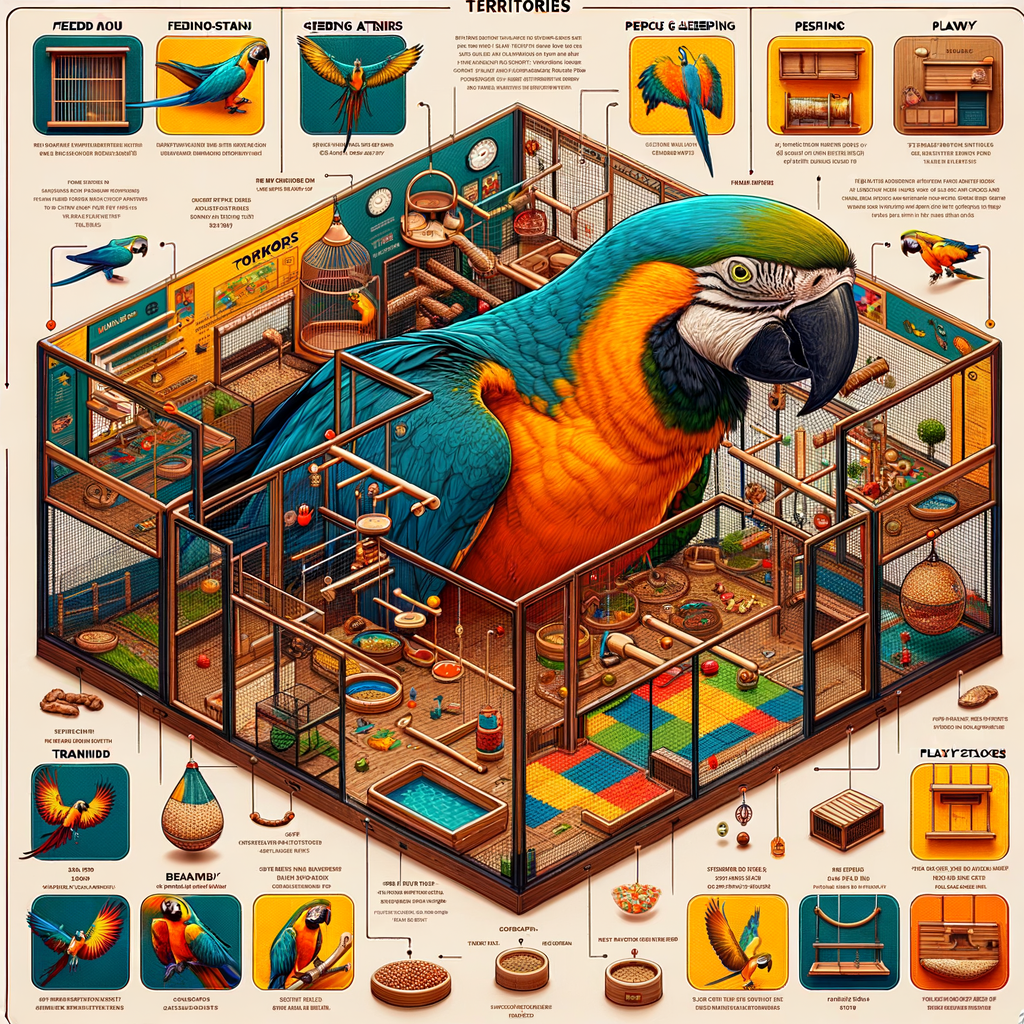
Introduction to Macaw Territory
Macaws, known for their vibrant colors and sociable nature, are a favorite among bird enthusiasts. However, these beautiful creatures require a specific environment to thrive. This section will help you understand the concept of a Macaw’s territory and the importance of establishing boundaries for these birds.
- Understanding the Concept of Macaw Territory
- The Importance of Establishing Boundaries for Macaws
Macaws, like many other birds, are territorial creatures. This means they need a specific area they can call their own. This territory is not just a physical space; it’s a place where they eat, sleep, play, and feel safe. It’s their home, their castle, their world. In the wild, Macaws have a vast territory, often spanning several miles. However, in a domestic setting, their territory is usually the cage where they live and the surrounding area.
Establishing boundaries for your Macaw is crucial for their wellbeing. Without clear boundaries, Macaws can become stressed, confused, and even aggressive. They need to know where their territory begins and ends. This doesn’t mean they should be confined to their cage all the time. On the contrary, they need time outside their cage to explore and play. However, they also need to understand that there are areas they cannot access, such as the kitchen or other rooms with potential hazards. By setting clear boundaries, you can ensure your Macaw feels secure and comfortable in their environment.
Understanding and respecting your Macaw’s territory is an essential step in creating a happy and healthy habitat for them. It’s not just about providing them with a cage; it’s about creating a space where they feel safe, comfortable, and loved. So, let’s dive deeper into the world of Macaws and learn how to create the perfect territory for these amazing creatures.
Macaw Home Setup
Setting up a home for your Macaw is a crucial step in ensuring their happiness and health. This section will focus on creating an ideal indoor territory for your feathered friend.
Indoor Macaw Territory
Macaws, like all birds, need a safe and comfortable environment to thrive. An indoor habitat can provide this, as long as it’s set up correctly. Let’s explore how to create a suitable indoor territory for your Macaw.
- Creating a safe and comfortable indoor environment for Macaws
- Essential items for an indoor Macaw habitat
- Cage: As mentioned, a large, sturdy cage is a must. It should be big enough for your Macaw to fully extend and flap their wings.
- Perches: Macaws need a variety of perches of different diameters, materials, and textures to help keep their feet healthy.
- Toys: Macaws are intelligent and curious birds that need mental stimulation. Provide a variety of toys to keep them entertained.
- Food and Water Dishes: Stainless steel or ceramic dishes are best as they are easy to clean and can’t be chewed up.
- Bird-Safe Plants: Some plants can provide natural perching and foraging opportunities. Just make sure they are safe for birds.
Firstly, it’s essential to ensure that the indoor environment is safe for your Macaw. This means removing any potential hazards, such as toxic plants, open windows, and small objects that could be swallowed. The room temperature should be kept between 65 and 85 degrees Fahrenheit, as Macaws are sensitive to cold.
Comfort is another important factor. Macaws need plenty of space to move around and stretch their wings. A large, sturdy cage is a must, but remember, the cage is their bedroom, not their home. They should be allowed out of their cage to explore and interact with their human family for several hours each day.
There are several items that are essential for an indoor Macaw habitat. These include:
Remember, setting up a comfortable and safe indoor environment for your Macaw will require time and effort, but the reward of a happy, healthy bird is well worth it.
Outdoor Macaw Territory
Creating a secure and comfortable outdoor space for your Macaw is just as important as setting up their indoor territory. Let’s explore how you can do this effectively.
- Creating a Secure Outdoor Space for Macaws
Macaws, being native to the tropical rainforests, love to be outdoors. They enjoy the fresh air, sunlight, and the opportunity to fly freely. However, their safety should be your top priority. Here’s how you can create a secure outdoor space for your Macaw:
- Enclosure: A sturdy and spacious aviary is essential. It should be large enough for your Macaw to fly and play around. The enclosure should be made of durable materials to prevent your Macaw from chewing through it.
- Security: Ensure the aviary is predator-proof. The doors should have secure locks, and the wire mesh should be small enough to prevent other animals from reaching in.
- Shelter: Part of the aviary should provide shelter against the elements. This could be a roofed section or a birdhouse within the enclosure.
- Key Considerations for an Outdoor Macaw Habitat
When setting up an outdoor habitat for your Macaw, there are several factors to consider:
- Location: The aviary should be placed in a quiet and safe location. Avoid areas with high traffic, loud noises, or potential threats like predators.
- Weather: Macaws are tropical birds, and they can be sensitive to cold temperatures. If you live in a region with cold winters, you might need to move your Macaw indoors during this time.
- Enrichment: Just like their indoor territory, the outdoor space should be filled with toys, perches, and other enrichment items to keep your Macaw entertained.
In conclusion, creating a secure and enriching outdoor territory for your Macaw requires careful planning and consideration. But with the right setup, your Macaw can enjoy the benefits of being outdoors while staying safe and secure.
Macaw Care
One of the most important aspects of taking care of your Macaw is understanding their dietary needs and how to feed them properly. In this section, we will discuss the feeding and nutrition of Macaws, including their dietary requirements and common feeding mistakes to avoid.
Feeding and Nutrition
Macaws, like all living creatures, have specific dietary requirements that need to be met for them to live a healthy and happy life. Let’s delve into what these requirements are and how you can ensure your Macaw is getting the nutrition it needs.
- Dietary requirements of Macaws
- Common feeding mistakes to avoid
Macaws are omnivores, which means they eat both plant and animal-based foods. Their diet should consist of a variety of fruits, vegetables, nuts, and seeds, along with a small amount of protein from sources like cooked eggs or lean meats. It’s also important to provide them with a high-quality pellet diet, which can help fill in any nutritional gaps.
One common mistake is overfeeding, which can lead to obesity and other health problems. Macaws should be fed a measured amount of food each day, rather than having a constant supply available. Another mistake is feeding them an improper diet, such as one that is too high in fat or low in nutrients. Lastly, never feed your Macaw chocolate, avocado, or alcohol, as these can be toxic to them.
By understanding the dietary needs of your Macaw and avoiding common feeding mistakes, you can help ensure your feathered friend stays healthy and happy. Remember, a well-fed Macaw is a happy Macaw!
Health and Wellness
Keeping your Macaw healthy and well is a crucial part of their care. This involves understanding common health issues and the importance of regular vet check-ups.
- Common health issues in Macaws
Macaws, like any other pet, can face a variety of health issues. Some of the most common include:
- Feather Plucking: This is often a sign of stress, boredom, or underlying health issues.
- Beak and Feather Disease: This viral infection can cause beak deformities and feather loss.
- Proventricular Dilatation Disease (PDD): This is a serious condition that affects the bird’s digestive system.
- Psittacosis: Also known as ‘parrot fever’, this bacterial infection can cause respiratory issues and lethargy.
It’s important to note that these are just a few examples. If your Macaw is showing any signs of illness, such as changes in behavior, loss of appetite, or unusual droppings, it’s crucial to seek veterinary advice immediately.
- Importance of regular vet check-ups
Regular vet check-ups are an essential part of your Macaw’s health and wellness. These check-ups allow the vet to catch any potential health issues early, before they become serious problems. They also provide an opportunity for the vet to monitor your bird’s weight and overall health, and to administer any necessary vaccinations.
During a check-up, your vet will likely conduct a physical examination of your bird, checking for any signs of illness or injury. They may also take blood samples for testing, and may recommend additional diagnostic tests if they suspect any health issues.
As a general rule, it’s recommended that Macaws have a vet check-up at least once a year. However, more frequent check-ups may be necessary for older birds, or those with existing health conditions.
In conclusion, understanding common health issues and ensuring regular vet check-ups are key to maintaining your Macaw’s health and wellness. By staying vigilant and proactive, you can help ensure your feathered friend lives a long, happy, and healthy life.
Understanding Macaw Behavior
Macaws, like all parrots, are known for their vibrant colors and lively personalities. But did you know that they also have a complex range of behaviors? Understanding these behaviors can help you form a stronger bond with your pet macaw, and ensure that they are happy and healthy in their home environment.
- Common behaviors and what they mean
- Screaming: Macaws are naturally loud birds, but excessive screaming can indicate stress or boredom. Try to provide more stimulation for your bird, like toys or interaction with you.
- Feather plucking: This can be a sign of stress, boredom, or health issues. If your macaw is plucking their feathers, it’s a good idea to consult with a vet.
- Head bobbing: This is a normal behavior and often means your macaw is happy and excited.
- Regurgitation: If your macaw is regurgitating food, they might be trying to show affection. It’s a normal behavior, but if it’s excessive, it could be a sign of a health problem.
- How to respond to different behaviors
- Screaming: Try to find the cause of the stress or boredom and address it. More toys, interaction, or a change in environment might help.
- Feather plucking: Consult with a vet to rule out any health issues. If it’s due to stress or boredom, try to provide more stimulation.
- Head bobbing: This is a positive behavior, so you can respond by interacting with your macaw or giving them a treat.
- Regurgitation: If it’s a sign of affection, you can gently discourage it if you’re uncomfortable. If it’s excessive, consult with a vet.
Macaws are expressive birds and their behaviors can tell us a lot about how they’re feeling. Here are some common behaviors and what they might mean:
Responding correctly to your macaw’s behaviors can help strengthen your bond and ensure their well-being. Here’s how you can respond to some common behaviors:
Remember, every macaw is unique and might display behaviors differently. The key is to spend time with your bird, observe them, and respond to their needs. With understanding and patience, you can form a strong bond with your macaw and create a happy and healthy environment for them.
Creating Macaw Space
Creating a suitable space for your Macaw is an essential part of their care. This space should be safe, comfortable, and stimulating for your feathered friend. One of the most important aspects of this space is setting boundaries. Let’s delve into why boundaries are important and how to effectively set them.
Setting Boundaries for Macaws
Setting boundaries for your Macaw is a crucial part of their care and training. It helps them understand where they can and cannot go, which can prevent accidents and keep them safe. Here’s why boundaries are important and how to set them effectively.
- Why boundaries are important
- How to effectively set boundaries
Boundaries are important for a few reasons. Firstly, they keep your Macaw safe. By setting boundaries, you can prevent your Macaw from accessing dangerous areas like the kitchen, where they could potentially get hurt. Secondly, boundaries can help your Macaw feel more secure. Just like humans, Macaws need their own space where they can relax and feel safe. Lastly, boundaries can help prevent damage to your home. Macaws are curious and can be destructive, so setting boundaries can help protect your belongings.
Setting boundaries for your Macaw can be done in a few steps. Firstly, identify the areas where you want to set boundaries. These could be rooms or specific areas within a room. Next, use physical barriers like baby gates or closed doors to keep your Macaw out of these areas. You can also use visual cues like colored tape to help your Macaw understand where they can and cannot go. Lastly, reinforce these boundaries through training. Reward your Macaw when they stay within the boundaries and gently redirect them when they try to cross them. Remember, patience and consistency are key when setting boundaries.
In conclusion, creating a suitable space for your Macaw involves setting clear and effective boundaries. This not only keeps your feathered friend safe but also helps them feel secure and prevents damage to your home. With patience and consistency, you can create a happy and healthy space for your Macaw.
Macaw Training
Training your Macaw is an essential part of their development and well-being. It not only stimulates their mind but also strengthens the bond between you and your feathered friend. Let’s delve into some basic training techniques that can help your Macaw become more obedient and interactive.
Basic Training Techniques
Before we begin, remember that patience and consistency are key when it comes to training your Macaw. It’s also important to reward good behavior with treats and positive reinforcement. Now, let’s explore two fundamental training techniques:
-
Training your Macaw to follow boundaries
Macaws are intelligent birds and can learn to respect boundaries in your home. Start by setting clear boundaries, such as not allowing them on certain furniture or in specific rooms. Use a firm, but gentle voice to communicate these boundaries. Whenever your Macaw follows these rules, reward them with a treat or praise. This will encourage them to continue respecting these boundaries. Remember, consistency is key, and it may take some time for your Macaw to fully understand and respect these boundaries.
-
Teaching your Macaw basic commands
Teaching your Macaw basic commands like “step up”, “step down”, and “no” can be very beneficial. Start with the “step up” command. Hold your hand or arm out and say “step up”. If your Macaw steps onto your hand or arm, reward them with a treat. Repeat this process until your Macaw understands the command. Use the same process for the “step down” and “no” commands. Remember, patience and consistency are key in this process.
Training your Macaw can be a rewarding experience for both you and your feathered friend. It not only helps in managing their behavior but also strengthens your bond. So, start implementing these basic training techniques today and see the difference it makes.
Advanced Training Techniques
Once your Macaw has mastered the basic commands, it’s time to move on to more advanced training techniques. These techniques will not only stimulate your Macaw’s mind but also provide them with a sense of freedom and fulfillment. Let’s delve into two of these advanced techniques: training your Macaw for free flight and teaching your Macaw to talk.
- Training your Macaw for Free Flight
Free flight training is a remarkable way to allow your Macaw to experience the joy of flying while still ensuring their safety. Here are some steps to follow:
| Step | Description |
|---|---|
| 1 | Start with short distances in a safe, enclosed space. |
| 2 | Gradually increase the distance as your Macaw becomes more confident. |
| 3 | Always supervise your Macaw during free flight sessions to ensure their safety. |
- Teaching your Macaw to Talk
Macaws are known for their ability to mimic human speech. Teaching your Macaw to talk can be a fun and rewarding experience. Here’s how:
| Step | Description |
|---|---|
| 1 | Start with simple words or phrases and repeat them frequently. |
| 2 | Always use a clear, enthusiastic voice to encourage your Macaw. |
| 3 | Remember, patience is key. It may take time for your Macaw to start mimicking your speech. |
Remember, every Macaw is unique and may learn at a different pace. The most important thing is to make the training process enjoyable for both you and your feathered friend. Happy training!
Case Studies: Successful Macaw Home Setup
Let’s take a look at two real-life examples of successful macaw home setups. These case studies will provide you with practical insights and ideas to create a comfortable and safe environment for your macaw.
- Case Study 1: Creating an Indoor Macaw Territory
- Case Study 2: Establishing Boundaries for Outdoor Macaw Space
Meet Jane, a bird enthusiast who successfully created an indoor territory for her macaw, Polly. Jane transformed her spare room into a macaw-friendly space, equipped with bird-safe plants, a large cage, and plenty of toys.
She used a variety of perches at different heights to mimic a natural environment. Jane also installed a bird bath for Polly to bathe and play. She ensured the room was well-lit and maintained a consistent temperature.
By regularly cleaning the room and providing fresh food and water, Jane made sure Polly was healthy and happy. This case study shows that with careful planning and consideration, it’s possible to create a thriving indoor environment for a macaw.
Next, let’s look at how Tom, a macaw owner, established boundaries for his macaw, Rio, in an outdoor space. Tom had a large backyard, which he wanted to make safe for Rio.
He built a large outdoor aviary with strong, bird-safe wire mesh. The aviary was spacious enough for Rio to fly and play. Tom also included a variety of perches and toys to keep Rio entertained.
Tom made sure the aviary was predator-proof and weather-resistant. He also planted bird-safe plants around the aviary to provide natural shade. By setting clear boundaries and considering safety measures, Tom created a secure outdoor space for Rio.
These case studies highlight the importance of planning and consideration in setting up a macaw home. Whether you’re creating an indoor or outdoor space, remember to consider your macaw’s needs and safety.
Conclusion: Creating a Happy and Healthy Macaw Habitat at Home
As we wrap up our discussion on macaw care, it’s important to remember that creating a happy and healthy habitat for your macaw at home is a rewarding but demanding task. It requires patience, dedication, and a deep understanding of your bird’s needs. Let’s recap the key takeaways from this article and share some final thoughts on macaw care and training.
- Key takeaways from the article:
- Final thoughts on Macaw care and training:
Understanding your macaw’s natural habitat and behavior is crucial. Macaws are intelligent and social creatures that need plenty of mental stimulation and social interaction. They require a spacious and safe environment, with plenty of toys and perches to keep them entertained. Regular cleaning and maintenance of their habitat is also essential to prevent diseases.
Macaw care involves a balanced diet rich in fruits, vegetables, and high-quality pellets. Regular vet check-ups are necessary to ensure your macaw’s health. Training your macaw requires patience and consistency, using positive reinforcement techniques.
Macaws are not just pets, they are companions that can live up to 50 years or more. Therefore, deciding to bring a macaw into your home should not be taken lightly. It’s a long-term commitment that requires time, effort, and resources. But with the right care and training, your macaw can become a loving and entertaining member of your family.
Remember, every macaw is unique and may require different care and training methods. Always be observant of your macaw’s behavior and adjust your care and training methods accordingly. With love, patience, and understanding, you can create a happy and healthy habitat for your macaw at home.






